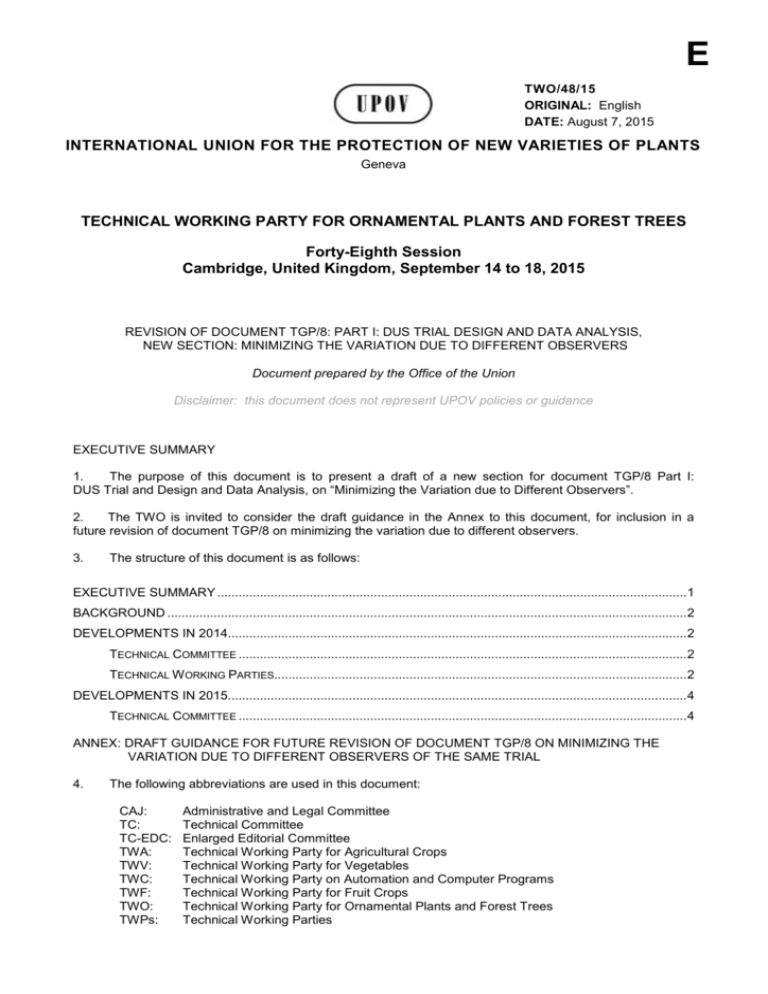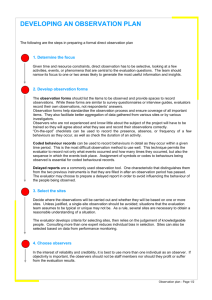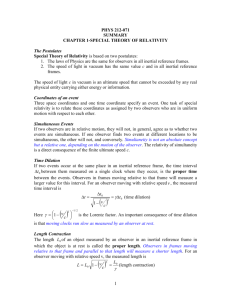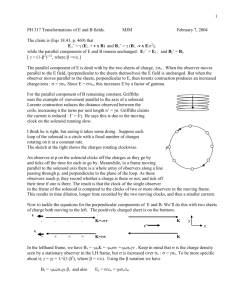Part I: DUS Trial Design and Data Analysis, New Section
advertisement

E TWO/48/15 ORIGINAL: English DATE: August 7, 2015 INTERNATIONAL UNION FOR THE PROTECTION OF NEW VARIETIES OF PLANTS Geneva TECHNICAL WORKING PARTY FOR ORNAMENTAL PLANTS AND FOREST TREES Forty-Eighth Session Cambridge, United Kingdom, September 14 to 18, 2015 REVISION OF DOCUMENT TGP/8: PART I: DUS TRIAL DESIGN AND DATA ANALYSIS, NEW SECTION: MINIMIZING THE VARIATION DUE TO DIFFERENT OBSERVERS Document prepared by the Office of the Union Disclaimer: this document does not represent UPOV policies or guidance EXECUTIVE SUMMARY 1. The purpose of this document is to present a draft of a new section for document TGP/8 Part I: DUS Trial and Design and Data Analysis, on “Minimizing the Variation due to Different Observers”. 2. The TWO is invited to consider the draft guidance in the Annex to this document, for inclusion in a future revision of document TGP/8 on minimizing the variation due to different observers. 3. The structure of this document is as follows: EXECUTIVE SUMMARY .................................................................................................................................... 1 BACKGROUND .................................................................................................................................................. 2 DEVELOPMENTS IN 2014................................................................................................................................. 2 TECHNICAL COMMITTEE .............................................................................................................................. 2 TECHNICAL W ORKING PARTIES.................................................................................................................... 2 DEVELOPMENTS IN 2015................................................................................................................................. 4 TECHNICAL COMMITTEE .............................................................................................................................. 4 ANNEX: DRAFT GUIDANCE FOR FUTURE REVISION OF DOCUMENT TGP/8 ON MINIMIZING THE VARIATION DUE TO DIFFERENT OBSERVERS OF THE SAME TRIAL 4. The following abbreviations are used in this document: CAJ: TC: TC-EDC: TWA: TWV: TWC: TWF: TWO: TWPs: Administrative and Legal Committee Technical Committee Enlarged Editorial Committee Technical Working Party for Agricultural Crops Technical Working Party for Vegetables Technical Working Party on Automation and Computer Programs Technical Working Party for Fruit Crops Technical Working Party for Ornamental Plants and Forest Trees Technical Working Parties TWO/48/15 page 2 BACKGROUND 5. Document TGP/8/1 Draft 7 PART I, paragraph 2.9.1: “Control of variation due to different observers”, considered by the Technical Working Parties, at their sessions in 2007, states: “[If this section is required, TWPs are invited to contribute guidance on the control of variation due to different observers when statistical analysis is not used to determine distinctness and to consider it in relation to paragraph 2.7.2.9.]” 6. Developments prior to 2014 are presented in document TC/50/21 “Revision of document TGP/8: Part I: DUS Trial Design and Data Analysis, New Section: Minimizing the Variation due to Different Observers”. DEVELOPMENTS IN 2014 Technical Committee 7. The TC at its fiftieth session, held in Geneva from April 7 to 9, 2014, considered document TC/50/21 “Revision of document TGP/8: Part I: DUS Trial Design and Data Analysis, New Section: Minimizing the Variation due to Different Observers”. 8. The TC noted that the TWF had requested an expert from New Zealand to report, at its session in 2014, on the previous work done on harmonized variety description for apple for an agreed set of varieties (see document TC/50/36 “Report on the Conclusions”, paragraph 46). 9. The TC invited the expert from Australia, with the assistance of experts from the European Union, France, Germany, the Netherlands and the United Kingdom, to draft further guidance to be included in a future revision of document TGP/8 on minimizing the variation due to different observers, including guidance on PQ and QN/MG characteristics, for consideration by the TWPs at their sessions in 2014 (see document TC/50/36 “Report on the Conclusions”, paragraph 47). 10. In response to the request of the TC, the drafter from Australia (Mr. Nik Hulse) with the assistance of experts from the European Union, France, Germany, the Netherlands and the United Kingdom, provided draft guidance for future revision of document TGP/8 on minimizing the variation due to different observers, including guidance on PQ and QN/MG characteristics, for consideration by the TWPs at their sessions in 2014. 11. The expert from Australia proposed that the following points should be considered by the TWPs for future inclusion or clarification into the next draft of the guidance for future revision of document TGP/8 on minimizing the variation due to different observers: As already indicated in the draft, QN/MG can be dealt with in a similar way as QN/MS. However, it is important to note that in the case of QN/MG, the possible effect of random within-plot variation should also be considered. Further consideration is required on how to incorporate guidance on PQ characteristics. It should be explained that TGP/14 is another useful tool in clarifying many PQ characteristics (e.g. shape). Differences between observers could possibly be tested by frequency of deviations. Currently the document focus is on variation between observers at the authority level. Consideration could be given to whether minimizing observer variation between authorities should be mentioned in this document or, perhaps, a separate future document. Noting that such a consideration would introduce a greater number of factors such as GxE variation, sampling methods and ring tests. Technical Working Parties 12. The TWO, TWF, TWC, TWV and TWA considered documents TWO/47/15, TWF/45/15, TWC/32/15, TWV/48/15 and TWA/43/15 “Revision of Document TGP/8: Part I: DUS Trial Design and Data Analysis, New Section: Minimizing the Variation due to Different Observers”, respectively (see document TWO/47/28 “Report”, paragraphs 39 to 41 , document TWF/45/32 “Report”, paragraphs 26 to 32, document TWC/32/28 TWO/48/15 page 3 “Report”, paragraphs 50 to 53, document TWV/48/43 document TWA/43/27 “Report”, paragraphs 28 to 33 ). “Report”, paragraphs 34 to 37 and 13. The TWO noted that the TWF had requested an expert from New Zealand to report at its session in 2014, on the previous work done on harmonized variety description for apple for an agreed set of varieties, as set out in document TWO/47/15, paragraph 18 (see document TWO/47/28 “Report”, paragraph 40). 14. The TWO, TWF, TWC, TWV and TWA agreed that the draft guidance presented at their sessions in the Annex to documents TWO/47/15, TWF/45/15, TWC/32/15, TWV/48/15 and TWA/43/15, respectively, should continue to be developed for inclusion in a future revision of document TGP/8 on minimizing the variation due to different observers, including guidance on PQ and QN/MG characteristics, in conjunction with the points raised by the expert from Australia in documents TWO/47/15, TWF/45/15, TWC/32/15, TWV/48/15 and reproduced in paragraph 21 of this document (see documents TWO/47/28 “Report”, paragraph 41, TWF/45/32 “Report”, paragraph 27, TWC/32/28 “Report”, paragraph 52, TWV/48/43 “Report”, paragraph 34 and TWA/43/27 “Report”, paragraphs 30). 15. The TWO and the TWA agreed that the document should focus on variation between observers at the authority level and not on minimizing observer variation between authorities (see documents TWO/47/28 “Report”, paragraph 41 and TWA/43/27 “Report”, paragraph 31). 16. The TWF received a presentation from the experts from Germany and New Zealand on the previous work done on harmonized variety descriptions for apple for an agreed set of varieties, as reproduced in document TWF/45/28 (see document TWF/45/32 “Report”, paragraph 28). 17. The TWF agreed on the importance on minimizing the variation between different observers and also between authorities and therefore suggested to consider a study on the possibility to start a new project on harmonized variety description for an agreed set of varieties. The expert from Germany proposed to present to the TWF, at its forty-sixth session, a protocol for the project with an agreed list of varieties to be examined, in order to consider if it could be relevant to further develop the study (see document TWF/45/32 “Report”, paragraph 30). 18. The TWF and the TWV noted the importance of the quality of the Test Guidelines in providing clear guidance for DUS examiners and in ensuring the consistency of observations between observers within each authority, and the importance of the continuous training of examiners (see documents TWF/45/32 “Report”, paragraph 31 and TWV/48/43 “Report”, paragraph 35). 19. The TWF invited the expert from Australia to report, at its forty-sixth session, on the effect of location, observer and year on the conformity of a characteristic for a specific crop (see document TWF/45/32 “Report”, paragraph 32). 20. The TWC noted that the expert from New Zealand had reported at the forty-fifth session of the TWF on the previous work done on harmonized variety description for apple for an agreed set of varieties (see document TWC/32/28 “Report”, paragraph 51). 21. The TWC agreed that the draft guidance should start on variation between observers at the authority level and between different authorities at a future stage (see document TWC/32/28 “Report”, paragraph 53). 22. The TWV suggested the inclusion of a training exercise in a DUS trial as a basis to share experiences in the field and to enhance the use of the TWV for training (see document TWV/48/43 “Report”, paragraph 36). 23. The TWA noted that an expert from New Zealand had made a presentation at the forty-fifth session of the TWF on the previous work done on harmonized variety descriptions for apple for an agreed set of varieties, as presented in TWF/45/28 “Harmonized example varieties for Apple: historical data and possible new developments” (see document TWA/43/27 “Report”, paragraph 29). 24. The TWA noted the importance of the quality of the Test Guidelines for providing clear guidance for DUS examiners and for ensuring consistency of observations, and the importance of the continuous training of examiners. The TWA agreed to propose a general recommendation that, if possible, one observer should be used per trial to avoid variation in observations (see document TWA/43/27 “Report”, paragraph 32). TWO/48/15 page 4 25. The TWA agreed that QN/MG characteristics could be dealt with in a similar way to QN/MS and noted that the possible effect of random within-plot variation should also be considered. The TWA agreed that differences between observers on PQ characteristics could be tested using non-parametric methods, such as frequency of deviations (see document TWA/43/27 “Report”, paragraph 33). 26. In response to the comments made by the TWPs at their sessions in 2015, Mr. Nik Hulse (Australia), prepared a new draft of guidance to be included in TGP/8 Part I:DUS Trial and Design and Data Analysis, New Section: Minimizing the Variation due to Different Observers, as reproduced in the Annex to document TC/51/16, for consideration by the TWPs at their sessions in 2015. DEVELOPMENTS IN 2015 Technical Committee 27. The TC, at its fifty-first session, held in Geneva, from March 23 to 25, 2015, considered document TC/51/16 “Revision of document TGP/8: Part I: DUS Trial Design and Data Analysis, New Section: Minimizing the Variation due to Different Observers“ and the draft guidance for inclusion in document TGP/8 on minimizing the variation due to different observers of the same trial, as reproduced in the Annex to document TC/51/16, in conjunction with the comments of the TWPs at their sessions in 2014 (see document TC/51/39, paragraph 132). 28. The TC agreed to request the expert from Australia to continue developing the document to be presented to the TWPs at their sessions in 2015, and to amend the title to that used in the Annex to document TC/51/16 “Minimizing the variation due to different observers of the same trial” (see document TC/51/39, paragraph 133). 29. In response to the request of the TC, the drafter from Australia (Mr. Nik Hulse), has provided revised draft guidance for future revision of document TGP/8 on minimizing the variation due to different observers, for consideration by the TWPs at their sessions in 2015, as presented in the Annex to this document. 30. The TWO is invited to consider the draft guidance in the Annex to this document, for inclusion in a future revision of document TGP/8 on minimizing the variation due to different observers. [Annex follows] TWA/48/15 ANNEX TGP/8/1: PART I: NEW SECTION: MINIMIZING THE VARIATION DUE TO DIFFERENT OBSERVERS OF THE SAME TRIAL Compared to the version presented to the TC at its fifty-first session, the proposed changes are presented below in highlight and underline (insertion) and strikethrough (deletion). 1. Introduction This document considers variation between observers of the same trial at the authority level. It has been prepared with QN/MG, QN/MS, QN/VG and QN/VS characteristics in mind. It does not explicitly deal with PQ characteristics like color and shape. The described Kappa method in itself is largely applicable for these characteristics, e.g. the standard Kappa characteristic is developed for nominal data. However, the method has not been used on PQ characteristics to our knowledge and PQ characteristics may also require extra information on calibration. As an example, for color calibration, you also have to take into account the RHS Colour chart, the lighting conditions and so on. Differences between observers on PQ characteristics could be tested using non-parametric methods, such as frequency of deviations.These aspects are not covered in this document. 1.1 Variation in measurements or observations can be caused by many different factors, like the type of crop, type of characteristic, year, location, trial design and management, method and observer. Especially for visually assessed characteristics (QN/VG or QN/VS) differences between observers can be the reason for large variation and potential bias in the observations. An observer might be less well trained, or have a different interpretation of the characteristic. So, if observer A assesses variety 1 and observer B variety 2, the difference observed might be caused by differences between observers A and B instead of differences between varieties 1 and 2. Clearly, our main interest lies with the differences between varieties and not with the differences between the observers. It is important to realize that the variation caused by different observers cannot be eliminated, but there are ways to control it. 1.2 It is recommended that, wherever possible, one observer should be used per trial to minimize variation in observations due to different observers. 2. Training and importance of clear explanations of characteristics and method of observation 2.1 Training of new observers is essential for consistency and continuity of plant variety observations. Calibration manuals, supervision and guidance by experienced observers as well as the use of example varieties illustrating the range of expressions are useful ways to achieve this. 2.2 UPOV test guidelines try to harmonize the variety description process and describe as clearly as possible the characteristics of a crop and the states of expression. This is the first step in controlling variation and bias. However, the way that a characteristic is observed or measured may vary per location or testing authority. Calibration manuals made by the local testing authority are very useful for the local implementation of the UPOV test guideline. Where needed these crop-specific manuals explain the characteristics to be observed in more detail, and specify when and how they should be observed. Furthermore they may contain pictures and drawings for each characteristic, often for every state of expression of a characteristic. 2.43 The Glossary of Terms Used in UPOV Documents (TGP/14/2) provides useful guidance for clarifying many characteristics, in particular PQ characteristics. 2.34 Once an observer is trained it is important to ensure frequent refresher training and recalibration. 3. Testing the calibration 3.1 After training an observer, the next step could be to test the performance of the observers in a calibration experiment. This is especially useful for inexperienced observers who have to make visual observations (QN/VG and QN/VS characteristics). If making visual observations, they should preferably pass a calibration test prior to making observations in the trial. But also for experienced observers, it is useful to test themselves on a regular basis to verify if they still fulfill the calibration criteria. TWO/47/15 Annex, page 2 3.2 A calibration experiment can be set up and analyzed in different ways. Generally it involves multiple observers, measuring the same set of material and assessing differences between the observers. 4. Testing the calibration for QN/MG or QN/MS characteristics 4.1 For observations made by measurement tools, like rulers (often QN/MS characteristics), the measurement is often made on an interval or ratio scale. In this case, the approach of Bland and Altman (1986) can be used. This approach starts with a plot of the scores for a pair of observers in a scatter plot, and compare it with the line of equality (where y=x). This helps the eye gauging the degree of agreement between measurements of the same object. In a next step, the difference per object is taken and a plot is constructed with on the y-axis the difference between the observers and on the x-axis either the index of the object, or the mean value of the object. By further drawing the horizontal lines y=0, y=mean(difference) and the two lines y = mean(difference) ± 2 x standard deviation, the bias between the observers and any outliers can easily be spotted. Similarly we can also study the difference between the measurement of each observer and the average measurement over all observers. Test methods like the paired t-test can be applied to test for a significant deviation of the observer from another observer or from the mean of the other observers. 4.2 By taking two measurements by each observer of every object, we can look at the differences between these two measurements. If these differences are large in comparison to those for other observers, this observer might have a low repeatability. By counting for each observer the number of moderate and large outliers (e.g. larger than 2 times and 3 times the standard deviation respectively) we can construct a table of observer versus number of outliers, which can be used to decide if the observer fulfills quality assurance limits. 4.3 Other quality checks can be based on the repeatability and reproducibility tests for laboratories as described in ISO 5725-2. Free software is available on the ISTA website to obtain values and graphs according to this ISO standard. 4.4 In many cases of QN/MG or QN/MS, a good and clear instruction usually suffices and variation or bias in measurements between observers is often negligible. If there is reason for doubt, a calibration experiment as described above can help in providing insight in the situation. 4.5 In the case of QN/MG observations consideration and allowance may need to be given to the possible random within plot variation. 5. Testing the calibration for QN/VS or QN/VG characteristics 5.1 For the analysis of ordinal data (QN/VS or QN/VG characteristics), the construction of contingency tables between each pair of observers for the different scores is instructive. A test for a structural difference (bias) between two observers can be obtained by using the Wilcoxon Matched-Pairs test (often called Wilcoxon Signed-Ranks test). 5.2 To measure the degree of agreement the Cohen’s Kappa (κ) statistic (Cohen, 1960) is often used. The statistic tries to accounts for random agreement:κ = (P(agreement) – P(e)) / (1-P(e)), where P(agreement) is the fraction of objects which are in the same class for both observers (the main diagonal in the contingency table), and P(e) is the probability of random agreement, given the marginals (like in a Chi-square test). If the observers are in complete agreement the Kappa value κ = 1. If there is no agreement among the observers, other than what would be expected by chance (P(e)), then κ = 0. 5.3 The standard Cohen’s Kappa statistic only considers perfect agreement versus non-agreement. If one wants to take the degree of disagreement into account (for example with ordinal characteristics), one can apply a linear or quadratic weighted Kappa (Cohen, 1968). If we want to have a single statistic for all observers simultaneously, a generalized Kappa coefficient can be calculated. Most statistical packages, including SPSS, Genstat and R (package Concord), provide tools to calculate the Kappa statistic. 5.4 As noted, a low κ-value indicates poor agreement and values close to 1 indicate excellent agreement. Often scores between 0.6-0.8 are considered to indicate substantial agreement, and above 0.8 to indicate almost perfect agreement. If needed, z-scores for kappa (assuming an approximately normal distribution) are available. The criteria for experienced DUS experts could be more stringent than for inexperienced staff. 6. Trial design 6.1 If we have multiple observers in a trial, the best approach is to have one person observe one or more complete replications. In that case, the correction for block effects also accounts for the bias between TWO/47/15 Annex, page 3 observers. If more than one observer per replication is needed, extra attention should be given to calibration and agreement. In some cases, the use of incomplete block designs (like alpha designs) might be helpful, and an observer can be assigned to the sub blocks. In this way we can correct for systematic differences between observers. 7. Example of Cohen’s Kappa 7.1 In this example, there are three observers and 30 objects (plots or varieties).The characteristic is observed on a scale of 1 to 6. The raw data and their tabulated scores are given in the following tables: Variety V1 V2 V3 V4 V5 V6 V7 V8 V9 V10 V11 V12 V13 V14 V15 V16 V17 V18 V19 V20 V21 V22 V23 V24 V25 V26 V27 V28 V29 V30 Observer Observer Observer 1 2 3 1 1 1 2 1 2 2 2 2 2 1 2 2 1 2 2 1 2 2 2 2 2 1 2 2 1 2 3 1 3 3 1 3 3 2 2 4 5 4 2 1 1 2 1 2 2 2 3 5 4 5 2 2 3 1 1 1 2 2 2 2 1 2 1 1 1 6 3 6 5 6 6 2 1 2 6 6 6 2 6 2 5 6 5 6 6 5 4 4 4 TWO/47/15 Annex, page 4 Scores for variety V1 V2 V3 V4 V5 V6 V7 V8 V9 V10 V11 V12 V13 V14 V15 V16 V17 V18 V19 V20 V21 V22 V23 V24 V25 V26 V27 V28 V29 V30 1 3 1 0 1 1 1 0 1 1 1 1 0 0 2 1 0 0 0 3 0 1 3 0 0 1 0 0 0 0 0 2 0 2 3 2 2 2 3 2 2 0 0 2 0 1 2 2 0 2 0 3 2 0 0 0 2 0 2 0 0 0 3 0 0 0 0 0 0 0 0 0 2 2 1 0 0 0 1 0 1 0 0 0 0 1 0 0 0 0 0 0 0 4 0 0 0 0 0 0 0 0 0 0 0 0 2 0 0 0 1 0 0 0 0 0 0 0 0 0 0 0 0 3 5 0 0 0 0 0 0 0 0 0 0 0 0 1 0 0 0 2 0 0 0 0 0 0 1 0 0 0 2 1 0 6 0 0 0 0 0 0 0 0 0 0 0 0 0 0 0 0 0 0 0 0 0 0 2 2 0 3 1 1 2 0 The contingency table for observer 1 and 2 is: O1\O2 1 2 3 4 5 6 Total 1 3 0 0 0 0 0 3 2 10 5 0 1 0 1 17 3 2 1 0 0 0 0 3 4 0 0 0 1 0 0 1 5 0 0 0 1 0 2 3 6 0 0 1 0 0 2 3 Total 15 6 1 3 0 5 30 The Kappa coefficient between observer 1 and 2, κ(O1,O2) is calculated as follows: κ(O1,O2) = (P(agreement between O1 and O2) – P(e)) / (1 – P(e)) where: P(agreement) = (3+5+0+1+0+2)/30 = 11/30 ≈ 0.3667 (diagonal elements) P(e) = (3/30).(15/30) + (17/30).(6/30) + (3/30).(1/30) + (1/30).(3/30) + (3/30).(0/30) + (3/30).(5/30) ≈ 0.1867. (pair-wise margins) So κ(O1,O2) ≈ (0.3667-0.1867) / (1-0.1867) ≈ 0.22 This is a low value, indicating very poor agreement between these two observers. There is reason for concern and action should be taken to improve the agreement. Similarly the values for the other pairs can be calculated: κ(O1,O3) ≈ 0.72, κ(O2,O3) ≈ 0.22.Observer 1 and 3 are in good agreement. Observer 2 is clearly different from 1 and 3 and the reasons for the deviation requires further investigation (e.g. consider need for additional training). TWO/47/15 Annex, page 5 8. References Cohen, J. (1960) A coefficient of agreement for nominal scales. Educational and Psychological Measurement 20: 37-46. Cohen, J. (1968) Weighted kappa: Nominal scale agreement provision for scaled disagreement or partial credit. Psychological Bulletin, 70(4): 213-220. Bland, J. M. Altman D. G. (1986) Statistical methods for assessing agreement between two methods of clinical measurement, Lancet: 307–310. http://www.seedtest.org/en/stats-tool-box-_content---1--1143.html (ISO 5725-2 based software) [End of document]






